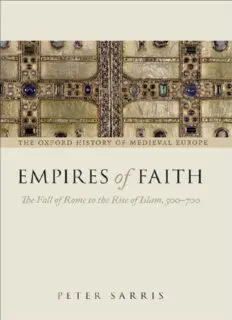
Empires of faith : the fall of Rome to the rise of Islam, 500-700 PDF
Preview Empires of faith : the fall of Rome to the rise of Islam, 500-700
THE OXFORD HISTORY OF MEDIEVAL EUROPE General Editors JINTY NELSON and HENRIETTA LEYSER Empires of Faith The Fall of Rome to the Rise of Islam, 500–700 PETER SARRIS Great Clarendon Street, Oxford OX2 6DP Oxford University Press is a department of the University of Oxford. It furthers the University’s objective of excellence in research, scholarship, and education by publishing worldwide in Oxford New York Auckland Cape Town Dar es Salaam Hong Kong Karachi Kuala Lumpur Madrid Melbourne Mexico City Nairobi New Delhi Shanghai Taipei Toronto With offices in Argentina Austria Brazil Chile Czech Republic France Greece Guatemala Hungary Italy Japan Poland Portugal Singapore South Korea Switzerland Thailand Turkey Ukraine Vietnam Oxford is a registered trade mark of Oxford University Press in the UK and in certain other countries Published in the United States by Oxford University Press Inc., New York © Peter Sarris 2011 The moral rights of the author have been asserted Database right Oxford University Press (maker) First published 2011 All rights reserved. No part of this publication may be reproduced, stored in a retrieval system, or transmitted, in any form or by any means, without the prior permission in writing of Oxford University Press, or as expressly permitted by law, or under terms agreed with the appropriate reprographics rights organization. Enquiries concerning reproduction outside the scope of the above should be sent to the Rights Department, Oxford University Press, at the address above You must not circulate this book in any other binding or cover and you must impose the same condition on any acquirer British Library Cataloguing in Publication Data Data available Library of Congress Cataloging in Publication Data Data available Typeset by SPI Publisher Services, Pondicherry, India Printed in Great Britain on acid-free paper by MPG Books Group, Bodmin and King’s Lynn ISBN 978-0-19-926126-0 1 3 5 7 9 10 8 6 4 2 General Editors’ Preface The only traditional thing about this series is that its volumes will form a chronological sequence. Each volume will be single-authored and cover one or two centuries. Beyond coverage of the medieval time-span, the editors have shied away from insisting on uniformity of presentation, which can have a stultifying effect and lead to dissimilar periods finding themselves shoe-horned into common patterns. Instead, authors are encouraged, within whatever geographical frame they choose for their volume (and those will vary), to treat ‘Europe’ as broadly as possible, to break away from narrowly Eurocentric perspectives, and to range, as and when desirable, beyond Europe (e.g. to the Near East or North Africa). Each author will be free to emphasise, and connect, themes that they consider significant, in light of their own work and of contemporary trends in historiography. While we expect a concern with beliefs and ideas, values and sentiments to reflect history’s cultural turn, authors will offer individual interpretations of their chosen periods, reflecting as they consider appropriate on interdisciplinary approaches, especially via consideration of material culture. The editors’ intention is that each author’s distinctive voice should be heard loud and clear, and we expect each volume to have its own unity and pace. Our authors have been liberated from the need to produce a standard authoritative account—always a rather chimerical concept—and we trust them to write with the energy and bravado such freedom unleashes. Every historian reflects the concerns of their own times: our series will be different only in so far as this will be an explicit aim. The editors will encourage authors to address twenty-first-century controversies when they think that their work offers useful connexions, comparisons and points of departure—for in this way the volumes will, we hope, contribute to better understandings of our own contemporary world. Jinty Nelson and Henrietta Leyser To my mother Patricia Sarris for her many years of love, labour, and support Contents List of Maps List of Figures Introduction and Acknowledgements 1. The World that had been Rome 1.1 Roman Imperialism from Augustus to the Third Century 1.2 The ‘Crisis’ of the Third Century 1.3 The Age of the Soldier Emperors 1.4 Diocletian, Constantine, and the Consolidation of the Late Roman State 1.5 The Late Roman Empire: Society and Institutions 1.6 The Demise of the Western Roman Empire 2. The Formation of Post-Roman Society 2.1 Introduction 2.2 The Decline of the Western Empire: Chronology and Facts 2.3 ‘Romans’ and ‘Barbarians’ in an Age of Transition 55 2.4 ‘Romanitas’ and its Limits 2.5 Continuity and Discontinuity in the Post-Roman Economy 3. The Romano-Germanic Kingdoms: The Era of Theoderic and Clovis 3.1 Introduction: The Building Blocks of the Romano-Germanic Kingdoms 3.2 Identity, Lordship, and Kingship 3.3 The Vandal Kingdom of Africa 3.4 The Kingdom of Odoacer in Italy 3.5 Theoderic and the Ostrogoths 3.6 The Struggle for Mastery in Italy 3.7 The Consolidation and Nature of Theoderic’s Regime 3.8 The Kingdom of Theoderic: Signs of Growing Tension 3.9 The Fall of the Ostrogothic Kingdom 3.10 The Roman Reconquest of Italy 3.11 The Frankish Expansion
